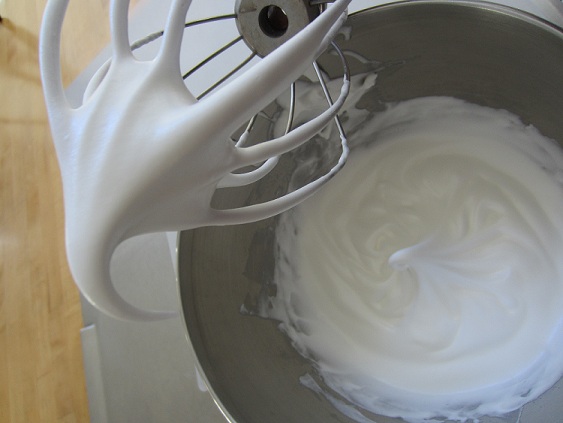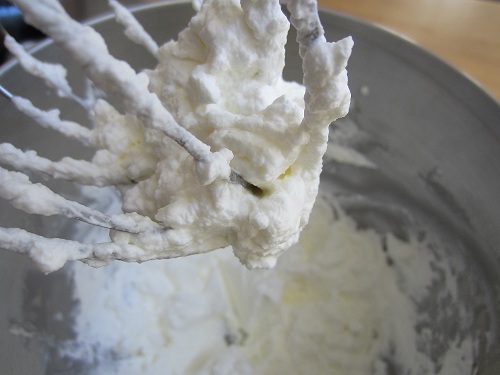How to Beat Egg Whites
 Friday, June 15, 2012 at 4:00AM
Friday, June 15, 2012 at 4:00AM 
By Colleen Boyd
Whipped egg whites have numerous applications. Some of the more common uses are to lighten cake batters, bake airy meringue cookies and to top pies.
But it can be intimidating when a recipe calls for whipped egg whites. You might find yourself asking one or all of these questions: Why do some recipes call for soft peaks and other for stiff peaks? When should I add the sugar? Can you over-beat egg whites?
Well don't worry, with a little inside information, the help of a few simple tricks and this video demo, you too can master this versatile technique!
Remember that water and fat are two elements that will prevent your egg whites from ever whipping-up properly. So make sure to use bowls and tools that are clean and have been thoroughly dried. This step is extremely important!
How to Crack the Eggs
Since egg yolk contains fat, you want to avoid getting even a smidgen of yoke into the separated whites. As a safety net, I use the three bowl method when separating eggs. Bowl 1: to separate the white from the yolk, dropping the white into this bowl and putting the yolks into Bowl 2. When the white has been cleanly separated, I transfer the white from Bowl 1 into Bowl 3 and start to separate the second egg using Bowl 1. This way if I break a yolk, I don’t ruin the entire batch of whites ; I only have to throw out the contents of Bowl 1. And since fat is the enemy of egg whites, if you do ruin the white and have to start over, make sure to wash and dry the bowl that has been contaminated with the egg yolk before separating the rest of your eggs.
When to Add the Sugar
One of the big steps some recipes seem to ignore is when to add the sugar. This step is as equally important as using a clean, dry bowl. Adding the sugar too soon and too much at a time has the same effect on egg whites as water does. Sugar melts as soon as it comes in contact with liquid or anything moist.
The solution is to whip the whites a little over a minute until they start to look light, foamy and not so liquefied. Slowly sprinkle in the sugar about 1 tablespoon at a time, to be safe. Sprinkle; do not dump sugar because a big clump of sugar will only deflate your egg whites.
When you’ve Over-Beaten
You'll notice when you over-whip whites they appear clumpy and start to seep a syrup-like liquid.  This is because the proteins in the whites have been wound so tight that all the liquid has been forced out. This is the point of no return. Sugar helps to keep the proteins in the whites relaxed so you can whip your whites longer. You'll notice meringue recipes always call for a lot of sugar for this very reason!
This is because the proteins in the whites have been wound so tight that all the liquid has been forced out. This is the point of no return. Sugar helps to keep the proteins in the whites relaxed so you can whip your whites longer. You'll notice meringue recipes always call for a lot of sugar for this very reason!
Colleen Boyd is on a mission to prove to all naysayers that health food doesn’t have to taste like cardboard! That a balanced diet is achievable on any type of budget or busy schedule. Colleen is currently the pastry assistant for Bar Bambino, Cafe & Wine Bar, located in the Mission District of San Francisco. She attended The International Culinary School at the Art Institute of California in San Francisco, where she excelled in the kitchen and bakeshop. As an aspiring writer, Colleen hopes to take her passion for all things pastry and culinary on the road, documenting her experiences from small cities to big countries.
Special Fork is a recipe website for your smartphone and PC that solves the daily dinnertime dilemma: what to cook now! Our bloggers blog Monday through Friday to give you cooking inspiration. Check out our recipe database for quick ideas that take no more than 30 minutes of prep time. Join the conversation on Facebook and follow us on Twitter.
Related posts:
 Special Fork Guest |
Special Fork Guest |  Post a Comment |
Post a Comment |  13 References | tagged
13 References | tagged  Special Fork,
Special Fork,  Video Friday,
Video Friday,  egg whites,
egg whites,  egg yolks,
egg yolks,  food blogs,
food blogs,  how to beat egg whites,
how to beat egg whites,  how to crack eggs to avoid contaminating whites with yolk,
how to crack eggs to avoid contaminating whites with yolk,  meringues,
meringues,  three bowl method,
three bowl method,  video recipes,
video recipes,  when to add the sugar,
when to add the sugar,  when you’ve overbeaten egg whites in
when you’ve overbeaten egg whites in  Guest Blogger,
Guest Blogger,  Video recipes
Video recipes
Reader Comments